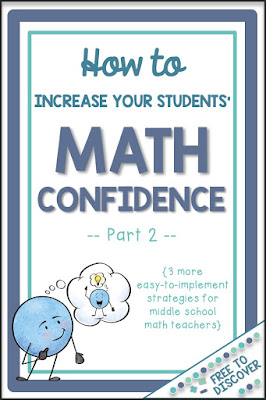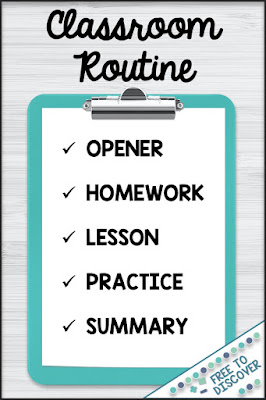In part one we discussed how to increase students’ math confidence by increasing skills fluency, providing specific written feedback, and engaging in reflections and corrections. Be sure to start there if you missed it. Today we’ll discuss how establishing routines, utilizing mixed groupings, and differentiating and planning based on student interests can help increase students’ math confidence.
1) Establish Routines
We know routines are an important part of classroom management. But have you thought about how establishing routines can help increase your students’ math confidence? When students know what to expect each day, they don’t need to spend much brainpower thinking about (or worrying about) what to expect. I recently read Atomic Habits* by James Clear. His research on habits is very much related to what we do as teachers in our classrooms. According to Clear, “Habit formation is the process by which a behavior becomes progressively more automatic through repetition. The more you repeat an activity, the more the structure of your brain changes to becomes efficient at that activity.” This is great news for teachers! Take the time to make your classroom routine automatic for your students, and their brain will actually become more efficient at it at a neurological level. When students can automatically arrive to class, follow the opening routine, and look at an agenda to see what to expect, they will feel more confident in their ability to meet or exceed expectations in that setting.
*I highly recommend this New York Times Bestseller to anyone looking to make improvement in their life through habit formation.
2) Utilize Mixed Groupings
It so challenging to create seating arrangements and groupings in middle school. You need to consider preferred seating accommodations, relationships, behaviors, and so much more. Taking the time to find the sweet spot to the best of your ability will pay off. Mixed grouping refers to having a variety of ability-levels together in one group. Mixed groupings work best when the positive peer model in a group or pairing is open to helping others and has modeled inclusive behavior. They should be respected by peers to the extent that others will accept their instruction and advice. It is also important that they understand that they should not do all the work for the group, but instead should serve as a leader to initiate discussions and work through problems together. To set expectations you may want to have one-on-one discussion with the peer model or group discussions with all students to ensure the group dynamics run successfully.
Once you have established mixed groupings, the benefits will be amazing to witness. Students who might not normally feel confident speaking in front of the whole class may be more willing to offer ideas and suggestions within a small group setting. Perhaps they will feel more confident taking risks by sharing ideas: a rarity in the middle school classroom. There are also benefits for the peer model students who may feel more confident after teaching and leading a small group of classmates. When one teaches others, they further instill the knowledge in their own mind and may even make new connections between mathematical ideas. Win-win. Utilizing mixed groupings will increase students’ math confidence for students working at any level.
3) Plan Based on Student Interests
I want to start with an anecdote here. When teaching high school students in an alternative education program how to determine the vertex of a quadratic function given different forms of the equation, I was getting some blank stares. It was, after all, a somewhat bland topic to develop the skills before diving deeper into the concept. One student in particular looked like he was about read to give up. We’ll call him Nathan. Nathan was totally lacking confidence in his math ability. He wanted to learn and do well, but he didn’t really believe in himself and the current methods were not helping him make the connections between math concepts that he needed. I noticed that Nathan really liked to draw, design, and color. Whenever he had free time, he would work on his clothing line sketches. Aha, Nathan is a budding artist who finds stress relief from art I realized. That night I went home and created a color-by-number activity to practice the math skill. It was a huge hit among all my students, but especially Nathan. Towards the end of class, he looked at me and said “I think you’re really trying to teach me. And it’s working.” I still get chills when I think about this moment.
Why am I sharing this? I believe it’s important to build relationships with your students and get to know their unique needs and interests. When making up word problems this could be a simple as using current students’ names or using scenarios that relate to the interests of particular students. If you have a student who loves horseback riding, create a real-world application about horseback riding. When students can connect to math concepts through their personal interests, they will experience greater engagement and increased confidence in their ability to solve the problem.
So friends, I don’t think I’m done here. I feel strongly that math confidence is the first step on the path to success in learning math. Comment below to let me know what you have found most striking or helpful. I plan to continue the series with more ideas for increasing students’ math confidence.
You might also be interested in:
Make sure you’re subscribed to the blog to receive notifications about new posts, sales, and exciting announcements. If you teach 8th grade math, you’ll receive the comprehensive 8th Grade Math Teacher Starter Kit. I have lots of love for other grade levels, too! You’ll receive a free hands-on Old Math Guy card game that can be used to increase students’ ability to convert between fractions and decimals. It’s a real confidence-builder!
Subscribe to the Free to Discover blog here:










No comments:
Post a Comment